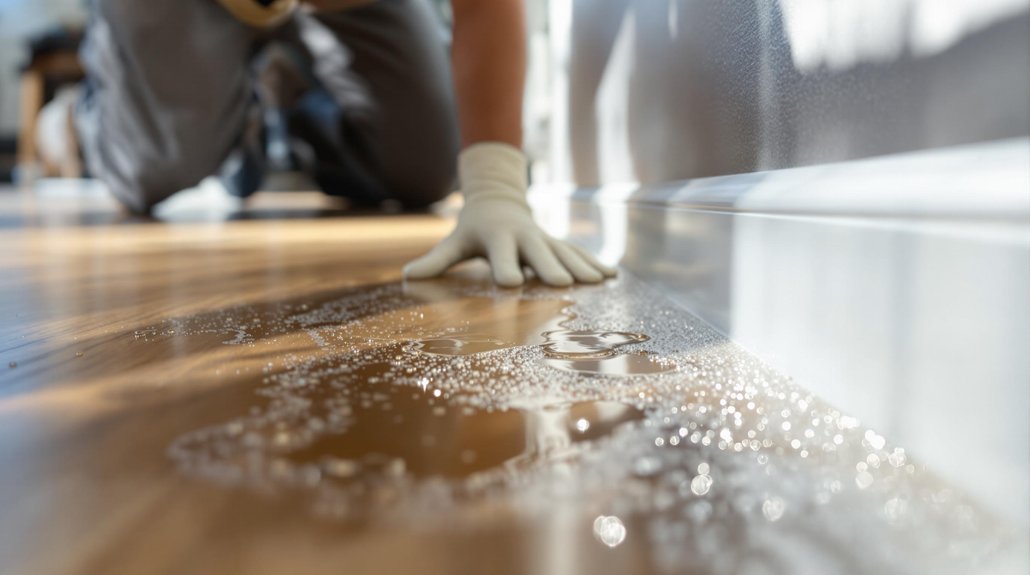
Exterminators focus on spraying baseboards because they are key entry points for pests. Many insects and rodents use gaps around baseboards to access homes. Cockroaches and ants especially are drawn to dark, moist areas near the floor. By treating these areas, exterminators target where pests are most likely to hide and nest. This method is an effective way to prevent infestations. Understanding more about pest behavior can highlight further prevention strategies.
Key Article Highlights
- Exterminators spray baseboards as they are common entry points for pests like ants and cockroaches.
- Baseboards attract dust and debris, which can lure pests into homes.
- Sealing gaps in baseboards enhances pest prevention by blocking entry points.
- Spraying baseboards targets areas where pests often hide and breed.
- Regular treatment of baseboards is essential for effective long-term pest control.
The Importance of Baseboards in Pest Control
Although often overlooked, baseboards play an important role in pest control. They are the first line of defense against pests. Proper baseboard maintenance helps keep homes safe. Dust and debris can gather along these edges, creating an inviting environment for insects. Regular cleaning removes these attractants and reduces pest activity. Additionally, sealing gaps in baseboards can prevent pests from entering. This simple step boosts pest prevention efforts considerably. Exterminators often focus on baseboards during treatments because pests frequently hide there. By targeting this area, they can eliminate existing infestations and deter future ones. Homeowners should prioritize baseboard upkeep to enhance their overall pest control strategy. A clean, well-maintained baseboard is crucial for a pest-free home. Furthermore, implementing routine inspections can significantly improve the effectiveness of pest control measures. Regularly addressing entry points helps ensure that pests are kept at bay and do not find their way into the living spaces. Exterminators also examine moisture zones near baseboards, as these areas can attract pests and provide favorable conditions for nesting.
How Pests Utilize Baseboards for Entry
Baseboards serve as a common entry point for various pests. Many insects and rodents seek shelter in the small spaces near the floor. These areas often contain baseboard gaps that create easy pest entryways. Ants, cockroaches, and mice can slip through these openings without much effort. They frequently use these gaps to find food, moisture, and nesting sites in homes. Additionally, cracks in the baseboards can widen over time, making it easier for pests to invade. When exterminators spray baseboards, they target these entry points to reduce pest populations. Sealing baseboard gaps can serve as an effective prevention strategy. This approach helps to minimize the risk of pest infestations in living spaces. Implementing insect growth regulators can further enhance the effectiveness of pest control efforts in these vulnerable areas. Furthermore, liquid soil treatments can be employed to create a barrier that deters pests from entering through these cracks. In addition to spraying, heat treatment is a powerful method to eliminate hidden infestations that may be lurking nearby.
The Science Behind Pest Behavior and Attraction

Understanding pest behavior is essential for effective pest control. Pests are drawn to specific environments based on their behavior patterns. Factors like food, moisture, and shelter play a significant role in pest attraction. For example, cockroaches seek dark, damp areas, while ants follow scent trails to food sources. The use of residual sprays can effectively target these areas where pests are most likely to be found.
Temperature also influences pest activity; many pests thrive in warm conditions. Changes in seasons can alter their behavior, causing them to seek indoors during colder months. Each pest species has unique habits that determine how and where they enter homes. By studying these behavior patterns, exterminators can target their treatments more effectively. This knowledge helps in creating a strategic plan to manage pest populations and minimize future infestations. Additionally, effective strategies like standing water management are crucial in preventing pest breeding and reducing their numbers.
Additional Strategies for Homeowners
Homeowners can take proactive steps to prevent pests from invading their spaces. Regular home maintenance is key. Sealing cracks and holes can block entry points for insects and rodents. Keeping food stored in airtight containers helps reduce food sources for pests. Additionally, homeowners should maintain a clean environment both indoors and outdoors. This includes sweeping floors and removing garbage regularly. Another effective strategy is to trim vegetation away from the home. This can minimize hiding spots for pests. Using pest prevention tips, such as installing screens on windows and doors, also enhances protection. By implementing these simple measures, homeowners can markedly lower their risk of pest infestations and create a safer living space.
When to Call a Professional Exterminator

Even with preventive measures in place, pest problems can still arise. Homeowners should be alert to signs of infestation. These may include droppings, damaged property, or strange noises. If any of these signs appear, it is time to call a professional exterminator. Ignoring the problem can lead to bigger issues. Pests can multiply quickly and create health risks. Professional exterminators have the tools and expertise needed for effective pest prevention. They can identify the source of the problem and apply safe treatments. It is wise to act promptly when signs of infestation are present. Early intervention can save time and money. Homeowners should not hesitate to seek help when pests invade their spaces.
Frequently Asked Questions
How Often Should I Have My Baseboards Treated for Pests?
Experts recommend treating baseboards every three to six months for effective pest prevention. Regular baseboard maintenance helps keep pests away. Following these pest prevention tips guarantees a cleaner, safer home environment for everyone.
Can I Spray Baseboards Myself?
Spraying baseboards for pests can be done through DIY pest control. However, one must take safety precautions, such as wearing gloves and masks, to avoid exposure to chemicals. It’s essential to follow instructions carefully.
What Pests Are Most Commonly Found Near Baseboards?
Pests near baseboards can be like hidden secrets waiting to be uncovered. Common culprits include ants, cockroaches, and termites. Effective pest identification techniques and regular baseboard maintenance tips are essential for prevention and control.
Are There Eco-Friendly Options for Treating Baseboards?
Eco-friendly options for treating baseboards include natural pest control methods and organic treatments. These approaches use non-toxic ingredients to deter pests, ensuring a safer environment for people and pets while effectively managing infestations.
How Long Does the Pesticide Last on Baseboards?
Pesticide longevity on baseboards varies. Typically, it lasts several weeks to months. Treatment efficacy depends on factors like the type of pesticide, environmental conditions, and surface characteristics. Regular inspections guarantee effective pest control over time.
Call today if you are in need of a pest exterminator in Round Rock, TX!
(512) 254-8185

